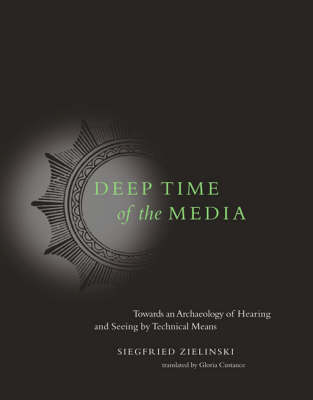
Deep Time of the Media
Toward an Archaeology of Hearing and Seeing by Technical Means
Seiten
2006
MIT Press (Verlag)
978-0-262-24049-9 (ISBN)
MIT Press (Verlag)
978-0-262-24049-9 (ISBN)
- Titel ist leider vergriffen;
keine Neuauflage - Artikel merken
A quest to find something new by excavating the "deep time" of media's development--not by simply looking at new media's historic forerunners, but by connecting models, machines, technologies, and accidents that have until now remained separated.
A quest to find something new by excavating the "deep time" of media's development - not by simply looking at new media's historic forerunners, but by connecting models, machines, technologies, and accidents that have until now remained separated. Deep Time of the Media takes us on an archaeological quest into the hidden layers of media development - dynamic moments of intense activity in media design and construction that have been largely ignored in the historical-media archaeological record. Siegfried Zielinski argues that the history of the media does not proceed predictably from primitive tools to complex machinery; in Deep Time of the Media, he illuminates turning points of media history - fractures in the predictable - that help us see the new in the old. Drawing on original source materials, Zielinski explores the technology of devices for hearing and seeing through two thousand years of cultural and technological history. He discovers the contributions of "dreamers and modelers" of media worlds, from the ancient Greek philosopher Empedocles and natural philosophers of the Renaissance and Baroque periods to Russian avant-gardists of the early twentieth century.
"Media are spaces of action for constructed attempts to connect what is separated," Zielinski writes. He describes models and machines - including a theatre of mirrors in sixteenth-century Naples, an automaton for musical composition created by the seventeenth-century Jesuit Athanasius Kircher, the eighteenth-century electrical tele-writing machine of Joseph Mazzolari, among others - that make this connection. Uncovering these moments in the media-archaeological record, Zielinski says, brings us into a new relationship with present-day moments; these discoveries in the "deep time" media history shed light on today's media landscape and may help us map our expedition to the media future.
A quest to find something new by excavating the "deep time" of media's development - not by simply looking at new media's historic forerunners, but by connecting models, machines, technologies, and accidents that have until now remained separated. Deep Time of the Media takes us on an archaeological quest into the hidden layers of media development - dynamic moments of intense activity in media design and construction that have been largely ignored in the historical-media archaeological record. Siegfried Zielinski argues that the history of the media does not proceed predictably from primitive tools to complex machinery; in Deep Time of the Media, he illuminates turning points of media history - fractures in the predictable - that help us see the new in the old. Drawing on original source materials, Zielinski explores the technology of devices for hearing and seeing through two thousand years of cultural and technological history. He discovers the contributions of "dreamers and modelers" of media worlds, from the ancient Greek philosopher Empedocles and natural philosophers of the Renaissance and Baroque periods to Russian avant-gardists of the early twentieth century.
"Media are spaces of action for constructed attempts to connect what is separated," Zielinski writes. He describes models and machines - including a theatre of mirrors in sixteenth-century Naples, an automaton for musical composition created by the seventeenth-century Jesuit Athanasius Kircher, the eighteenth-century electrical tele-writing machine of Joseph Mazzolari, among others - that make this connection. Uncovering these moments in the media-archaeological record, Zielinski says, brings us into a new relationship with present-day moments; these discoveries in the "deep time" media history shed light on today's media landscape and may help us map our expedition to the media future.
Siegfried Zielinski, a founder of the new field of media archaeology, is Founding Director of the Academy of Media Arts in Cologne, where he is Professor of Media and Communication Studies and is developing a workshop for a variantology of the media. He has published more than a dozen books and many articles. Deep Time of the Media is the second of his books to appear in English.
| Erscheint lt. Verlag | 31.1.2006 |
|---|---|
| Reihe/Serie | Electronic Culture: History, Theory and Practice S. |
| Übersetzer | Gloria Custance |
| Vorwort | Timothy Druckrey |
| Zusatzinfo | 86 |
| Verlagsort | Cambridge, Mass. |
| Sprache | englisch |
| Maße | 178 x 229 mm |
| Gewicht | 817 g |
| Themenwelt | Sozialwissenschaften ► Kommunikation / Medien ► Medienwissenschaft |
| Sozialwissenschaften ► Soziologie ► Empirische Sozialforschung | |
| ISBN-10 | 0-262-24049-1 / 0262240491 |
| ISBN-13 | 978-0-262-24049-9 / 9780262240499 |
| Zustand | Neuware |
| Haben Sie eine Frage zum Produkt? |
Mehr entdecken
aus dem Bereich
aus dem Bereich
wie KI und virtuelle Welten von uns Besitz ergreifen – und die …
Buch | Hardcover (2023)
Heyne (Verlag)
CHF 29,90
Eine Einführung
Buch | Softcover (2022)
Springer VS (Verlag)
CHF 46,15


